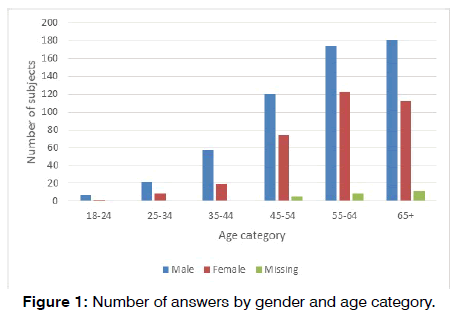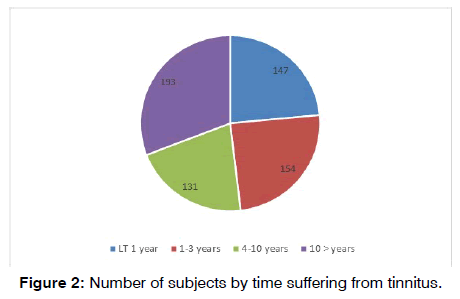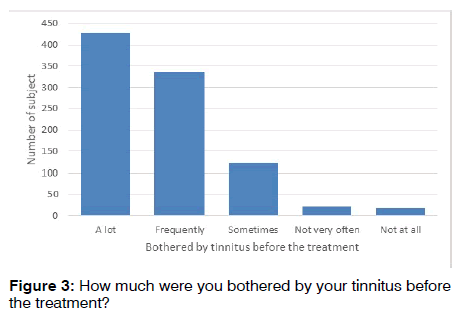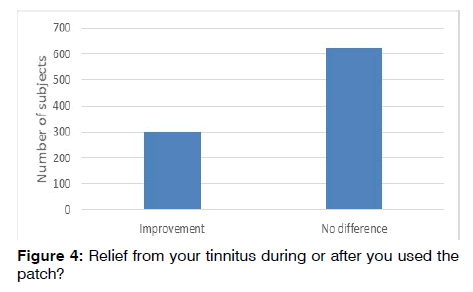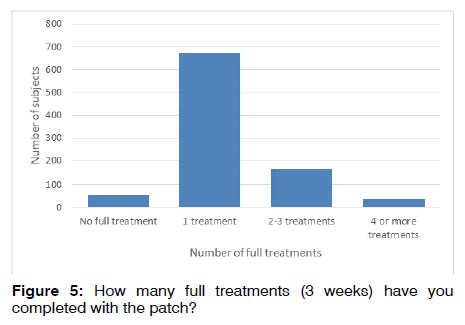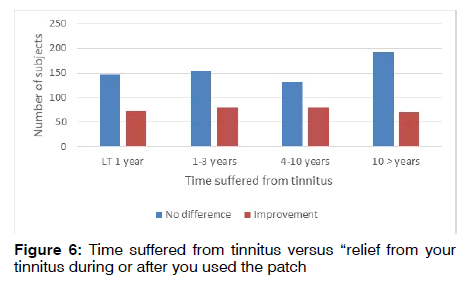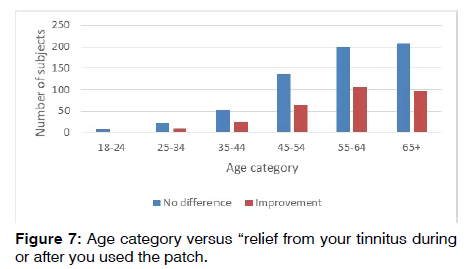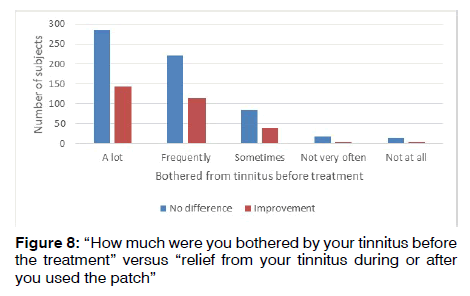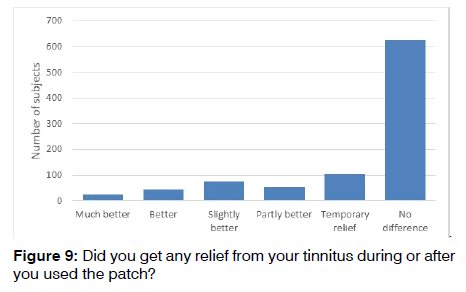The International Tinnitus Journal
Official Journal of the Neurootological and Equilibriometric Society
Official Journal of the Brazil Federal District Otorhinolaryngologist Society
ISSN: 0946-5448

Google scholar citation report
Citations : 12717
The International Tinnitus Journal received 12717 citations as per google scholar report
The International Tinnitus Journal peer review process verified at publons
Indexed In
- Excerpta Medica
- Scimago
- SCOPUS
- Publons
- EMBASE
- Google Scholar
- Euro Pub
- CAS Source Index (CASSI)
- Index Medicus
- Medline
- PubMed
- UGC
- EBSCO
Volume 24, Issue 2 / December 2020
Research Article Pages:108-113
10.5935/0946-5448.20200021
Post Market Clinical Follow up Results of the Steady State Coherent Bio-modulator Patch for tinnitus
Authors: Peter Ahnblad
PDF
Abstract
Objectives: To follow up with a survey for the safety and performance of the coherent biomodulator patch as a device for tinnitus when in clinical use.
Materials and methods: A survey with 20 questions was emailed to device users a few weeks after fulfilled treatment. Collected data from 927 responders from February 2017 to July 2020 was exported and analyzed. The treatment time was 3 weeks, and the patches were changed daily and placed behind one year. The analysis was performed in order to investigate the possibility of subgroups and if the effect of one or more treatments are different, and is the relief dependent on how long the users have had troublesome tinnitus, the age of the user, and the severity of the tinnitus.
Results: Most users were 45 years and older with a gender ratio of 1.65 men vs women. In general, the users reported highly bothersome tinnitus with 82% answering frequently to a lot before treatment. This follow up survey showed that 33% experienced any kind of improvement. The majority of those that reported improvement came from the subgroup of 4-10 years suffered from tinnitus. A very low frequency of side-effects was reported with no new risks or unexpected issues.
Conclusion: When considering the intended purpose of the steady state coherent biomodulator and the provided information in this survey, the device remains suitable for the intended tinnitus users.
Keywords: Tinnitus, medical device, post-market, skin patch, coherency, biomodulator
Introduction
Due to the complexity of tinnitus, most of the research regarding possible treatments focus on neuromodulation and neurostimulation, since it is linked to the neuronal activity in the brain and the auditory pathway [1,2]. When considering a different perspective, it could also be important to go from the concept of neuromodulation to the understanding of bio modulation, by including characteristics from ubiquitous water, which is not yet fully understood (Table 1) (Figure 1). Water accounts for most of the components of living organisms (70% mass and 99% of molar concentration), i.e. coherent correlations among biomolecules are phase-correlated and should exist in a coherent water state [3] .The coherency is also of interest in the brain; humans not suffering from tinnitus have a more consistence coherent state while tinnitus sufferers seem to have auditory cortex and thalamusamygdala hyperactivity [4,5] (Figure 2). Since the 1990s a technology developed in Sweden has been studied for creating bio modulation by a steady state coherent stage. This bio modulator is built up as a medical device by a microscopically small Fourier raster in a silica polyethylene terephthalate embedded in a patch for the skin. It is placed over the mastoid bone behind one ear and replaced daily for 3 weeks. Light photons are present both day and night and they passively pass through the patch and get organized in a coherent stage and affects the water and moisture close to the skin in a similar way, creating a spreading non-energy consuming selforganization process [6] (Table 2). There is a lack of similar bio modulators and clinical studies, but one study with 82 patients showed that it might have resetting effect on the auditory system by downregulating tinnitus awareness. One month after the treatment period there were 30% responders (decrease from baseline in at least 2 points on the tinnitus annoyance VAS) with active patch and 10% for placebo patch, showing a significant statistically efficacy [7](Table 3). The patch was well-tolerated and safe. Therefor it was released as a non-expensive and risk-free medical device for consumers suffering from tinnitus to buy online and a larger market clinical follow-up survey was performed to evaluate the safety and performance.
| Gender | Age category | ||||||
| 18-24 | 25-34 | 35-44 | 45-54 | 55-64 | 65+ | Total | |
| Male | 7 | 22 | 57 | 120 | 174 | 181 | 561 |
| Female | 2 | 9 | 19 | 74 | 123 | 112 | 339 |
| Missing | 0 | 1 | 1 | 5 | 9 | 11 | 27 |
| Total | 9 | 32 | 77 | 199 | 306 | 304 | 927 |
Table 1: Number of answers by gender and age category.
| Time category | Number (%) of answers |
| < 1 year | 220 (24%) |
| 1-3 years | 234 (25%) |
| 4-10 years | 210 (23%) |
| 10 > years | 263 (28%) |
| Total | 927 (100%) |
Table 2: When I tried the patches I had suffered from tinnitus in.
| Category | Number (%) of answers |
| A lot | 428 (46%) |
| Frequently | 336 (36%) |
| Sometimes | 123 (13%) |
| Not very often | 22 (2%) |
| Not at all | 18 (2%) |
| Total | 927 (100%) |
Table 3: How much were you bothered by your tinnitus before the treatment?
Methods
A survey of 20 questions in total was emailed to all consumer customers who had online bought the treatment with the biomodulator patch to use for their tinnitus (Figure 3). The timeline was from 28th of February 2017 to 25th of July 2020. The total response rate was 951 responders/users with a completion rate of nearly 98%. The questions were about gender, age, country of living and following tinnitus specific questions:
What do you think started your tinnitus?
Audiological reason: noise -induced, hearing trauma, hearing loss by age (presbycusis) or by genetic reason or loss by unknown reason (Figure 4). Muscular/ joint tension reason; TMJ (temporomandibular joint) dysfunction, bruxism (excessive teeth grinding and jaw clenching), shoulder and neck pain, whiplash injury or others. Psychological reason; emotional stress, depression, anxiety, severe life event or others (Table 4).
| Category | Number (%) of answers |
| Much better | 25 (3%) |
| Better | 45 (5%) |
| Slightly better | 76 (8%) |
| Partly better | 53 (6%) |
| Temporary relief | 103 (11%) |
| No difference | 625 (67%) |
| Total | 927 (100%) |
Table 4: Did you get any relief from your tinnitus during or after you used the patch?
Otological reason; otitis (ear infection), perforation/hole in the ear drum, otosclerosis (abnormal bone growth in middle ear), Mb Ménière (inner ear fluid disorder) or other ear disorder. Vascular reason; vascular abnormality, atherosclerosis, migraine or Others.Drug related reason; salicylic acid (aspirin etc), NSAIDs (ibuprofen, naproxen etc), antibiotics, benzodiazepines, chemotherapy or others. Other (please specify). No idea. When I tried the patches, I had suffered from tinnitus in: < 1 year 1-3 years 4-10 years and 10 > years
How much were you bothered by your tinnitus before the treatment? Not at all Not very often Sometimes Frequently A lot (Figure 5)
Did you get any relief from your tinnitus during or after you used the (hidden trademark) patch?
• No difference Temporary relief Slightly better Partly better Better
How many full treatments (3 weeks) have you completed with the (hidden trademark) Patch? No full treatment 1 treatment 2-3 treatments 4 or more treatments are you suffering from hyperacusis? Yes No
How much were you bothered by hyperacusis before the treatment? Not at all Slightly Partly Much Very much
Did you get any relief from hyperacusis during or after you used the (hidden trademark) patch?
• No difference
• Temporary relief
• Slightly better
• Partly better
• Better
• Much better
Have you experienced any side effects of the patches? Yes
• No
Did you stop using the patches due to the side effects? Yes
• No
Are you still experiencing side effects? Yes
• No
Have you tried any other treatment against tinnitus?
• No
• Medicinal
• Psychological
• Masking devices
• Hearing aid(s)
• Physiotherapy
• Relaxation
• Bite realignment
• Other (please specify)
How did you hear about the Patch (hidden trademark)? Doctor or other professional expertise
• From a friend
• Social media
• Search online
• Online advertising
• Article or report about tinnitus
Based on your overall experience, would you recommend the Tinnitus Patches to other suffering from tinnitus? Yes, absolutely
• Yes, likely
• Maybe
• No
• Definitely not
It should be noted that all the users that elected to respond have been included, no specific inclusion or exclusion criteria was applied.
• Significant
Results
The answers came from 56 different countries with the United Kingdom, Australia and Sweden covering 569 users corresponding to 60% of total. Men dominated by representing 60% of the responders (Figures 6 and 7). 40% responded audiological reasons for their tinnitus, 19% psychological reasons, 12% muscular or joint tension reasons, 24% (Table 5) had no idea, and the rest reported various reasons such as vascular, infections or drugs. The frequency of answers by gender and age show a higher response from the older age category which would be expected as it is in line with the risk group of tinnitus the answers indicate an even distribution of responses related to the duration of experienced inconvenience of tinnitus (Table 6). This distribution is probably a result of how the question and time span of the form is structured (Figure 8). The response rate shows that most of the responders had either a frequent or very often occurrence of tinnitus before the treatment. When combining the responses to review the group that reported any positive change/improvement after the treatment, more than a third of the responders experienced an improvement after using the device. Most of the users that answered the questionnaire, had completed one treatment, but there were also around a fifth of the users who had completed two or more treatments (Table 7).
| Category | Number (%) of answers |
| Improvement | 302 (33%) |
| No difference | 625 (67%) |
| Total | 927 (100%) |
Table 5: Did you get any relief from your tinnitus during or after you used the patch? (number of answers “much better”, “better”, “slightly better”, partly better” and “temporary relief” summarised into the category “Improvement”)
| Category | Number (%) of answers |
| No full treatment | 53 (6%) |
| 1 treatment | 672 (72%) |
| 2-3 treatments | 164 (18%) |
| 4 or more treatments | 38 (4%) |
| Total | 927 (100%) |
Table 6: How many full treatments (3 weeks) have you completed with the patch?
| Category | Number (%) of answers |
| No | 839 (91%) |
| Yes | 88 (9%) |
Table 7: Have you experienced any side effects of the patches
The response frequency indicates that the highest number of responders that experienced improvement was found in the group that had suffered from tinnitus 4-10 years (Table 8).
| Category | No Difference | Improvement | Total |
| LT 1 year | 147 (67%) | 73 (33%) | 220 (100%) |
| 1-3 years | 154 (66%) | 80 (34%) | 234 (100%) |
| 4-10 years | 131 (62%) | 79 (38%) | 210 (100%) |
| 10 > years | 193 (73%) | 70 (27%) | 263 (100%) |
| Total | 625 (67%) | 302 (33%) | 927 (100%) |
Table 8: Time suffered from tinnitus versus “relief from your tinnitus during or after you used the patch”
The responses indicate that an improvement and relief from the product may be experienced, regardless of the age of the user (Figure 9). Still, it seems that the main age group is among the older groups of the responders, with the peak at 55-65 years of age (Table 9).
| Category | No difference | Improvement | Total |
| 18-24 | 7 (78%) | 2 (22%) | 9 (100%) |
| 25-34 | 22 (69%) | 10 (31%) | 32 (100%) |
| 35-44 | 53 (69%) | 24 (31%) | 77 (100%) |
| 45-54 | 136 (68%) | 63 (32%) | 199 (100%) |
| 55-64 | 200 (65%) | 106 (35%) | 306 (100%) |
| 65+ | 207 (68%) | 97 (32%) | 304 (100%) |
| Total | 625 (67%) | 302 (33%) | 927 (100%) |
Table 9: Age category versus “relief from your tinnitus during or after you used the patch
The responses indicate that the users who were more bothered by their tinnitus experienced they were helped by the treatment. This may be as expected, as the questionnaire was designed to collect data on relief, and it is easier to measure relief if the affliction is more severe (Table 10).
| Category | No difference | Improvement | Total |
| A lot | 285 (67%) | 143 (33%) | 428 (100%) |
| Frequently | 222 (66%) | 114 (34%) | 336 (100%) |
| Sometimes | 84 (68%) | 39 (32%) | 123 (100%) |
| Not very often | 19 (86%) | 3 (14%) | 22 (100%) |
| Not at all | 15 (83%) | 3 (17%) | 18 (100%) |
| Total | 625 (67%) | 302 (33%) | 927 (100%) |
Table 10: “How much were you bothered by your tinnitus before the treatment” versus “relief from your tinnitus during or after you used the patch?
The results and respond frequency from the post treatment survey indicates that the responses were from users
• In all age-groups, the majority was by 45 years and above
• Of both genders, the majority being male
• With different duration of symptoms from less than 1 year to more than 10 years
• With different level of severity, but clear majority form a lot/frequently bothered
• Of which 33% experienced any kind of improvement
• Of which the majority have fulfilled one treatment
• Of which 91% responded that they had no experienced side-effects
• Of which the majority of those that reported improvement came from the subgroup of 4-10 yrs. suffered from tinnitus
• Of which the majority of those that reported improvement came from the subgroup of 55-65 yrs. of age
• Of which the majority of those that reported improvement came from the subgroup of a lot/frequently bothered
44% had not tried any treatment ever prior to the patch, 31% had tried physiotherapy or relaxation, 19% masking devices, 19% medicinal, 17% hearing aids, 11% psychological treatments, and the rest various treatments such as acupuncture, herbal treatments or vitamins.
Discussion
The male dominance in this survey is interesting since most demographic studies show that female tends to report more often tinnitus [8]. Maybe it is easier for men to absorb and try an innovative medical device, especially since it has a technically complicated background. The frequency of answers by age show a higher response from the older age category which would be expected as it is in line with the risk group of tinnitus and what many other studies have shown [9]. The answers indicate an even distribution of responses related to the duration of experienced inconvenience of tinnitus and that is also corresponding to other studies (Figure 10) [9]. The response rate shows that most of the responders had either a frequent or very often occurrence of tinnitus before the treatment, indicating that the more severely affected user seeks treatment, which is as expected. When combining the responses to review the group that reported any positive change/improvement after the treatment, more than a third of the responders experienced an improvement after using the device. This is in line of the results from the placebo-controlled study from 2017. Most of the users that answered the questionnaire, had completed one treatment, but there were also around a fifth of the users who had completed two or more treatments. The response frequency indicates a very low number of experienced side effects. 91% responded that they had no experienced side-effects. The highest number of responders that experienced improvement was found in the group that had suffered from tinnitus 4-10 years. The responses indicate that an improvement and relief from the product may be experienced, regardless of the age of the user. Still, it seems that the main age group is among the older groups of the responders, with the peak at 55-65 years of age. To get a more significant and uniform overview over the results it could have been better to have had the Visual-Analogue-Scale (VAS 0-100 mm) instead for responding different answers in the survey. This larger online survey showed therefore some interesting results about sufferers who tried the bio modulator patch. Altogether, it seems like a risk-free device and considering its efficacy it can be worth trying in the consumer field of treatments for tinnitus sufferers.
Conflict of Interest
There are no conflicts of interest in terms of the present study.
References
- Vanneste S, De Ridder D. Noninvasive and invasive neuromodulation for the treatment of tinnitus: an overview. Neuromodulation. 2012 Jul;15(4):350-60.
- Hoare DJ, Adjamian P, Sereda M. Electrical Stimulation of the Ear, Head, Cranial Nerve, or Cortex for the Treatment of Tinnitus: A Scoping Review. Neural Plast. 2016; 2016:5130503.
- Bono I, Del Giudice E, Gamberale L and Henry M. Emergence of the Coherent Structure of Liquid Water. Water 2012, 4(3), 510-532.
- Raichle ME, MacLeod AM, Snyder AZ, Powers WJ, Gusnard DA, Shulman GL. A default mode of brain function. Proc Natl Acad Sci U S A. 2001 Jan 16;98(2):676-82.
- Elgoyhen AB, Langguth B, De Ridder D, Vanneste S. Tinnitus: perspectives from human neuroimaging. Nat Rev Neurosci. 2015 Oct;16(10):632-42.
- Johansson B, Sukhotskaya S. Allometric scaling behaviour – A quantum dissipative state implies a reduction in thermal infrared emission and fractal ordering in distilled water. Water J. 2012; 3:100-121.
- Ahnblad P, Nordkvist A. A Randomized, Placebo-Controlled, Double-Blind, Parallel Groups Study Evaluating the Performance and Safety of a Steady State Coherent Biomodulator Patch in the Treatment of Subjective Tinnitus. Int Tinnitus J. 2017; 21(2): 157-167.
- Kim HJ et al. Analysis of the prevalence and associated risk factors of tinnitus in adults. PLoS One. 2015 May 28; 10(5).
- McCormack A, Edmondson-Jones M, Somerset S, Hall D. A systematic review of the reporting of tinnitus prevalence and severity. Hear Res. 2016 Jul; 337:70-9
Department of Oto-Rhino-Laryngology, Hästholmsvägen 28, 131 30 Nacka, Sweden
Send correspondence to:
Peter Åhnblad
Department of Oto-Rhino-Laryngology, Hästholmsvägen 28, 131 30 Nacka, Sweden, E-mail: peter@supramed.se Phone: +00313013130
Paper submitted on November 24, 2020; and Accepted on December 10, 2020
Citation: Post Market Clinical Follow up Results of the Steady State Coherent Bio-modulator Patch for tinnitus.24(2):108-113



